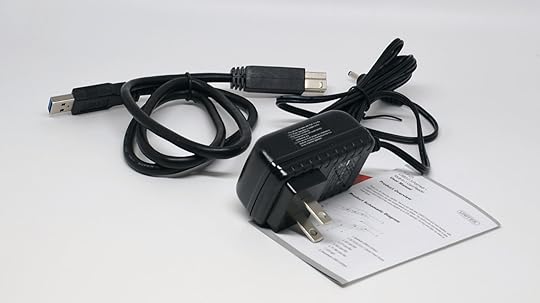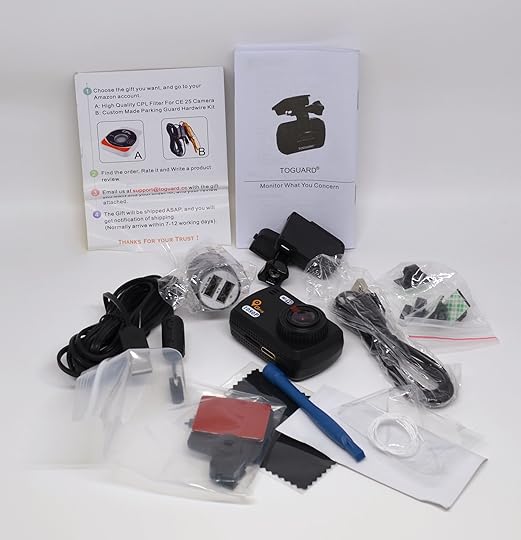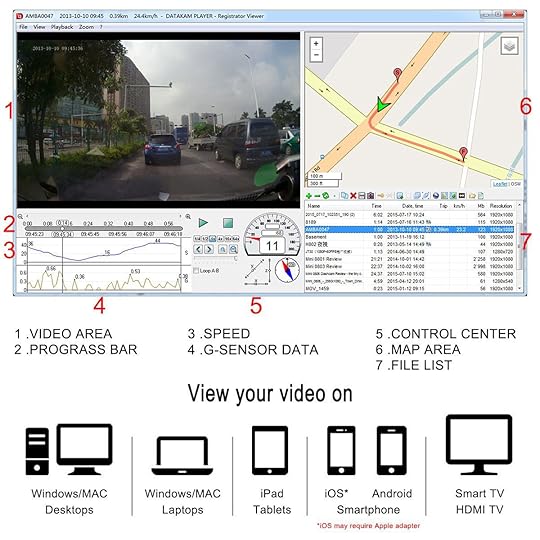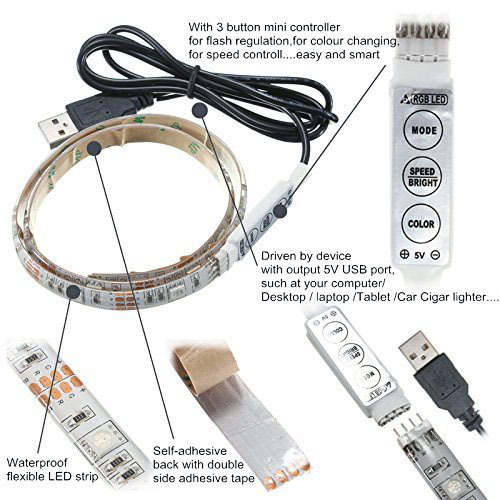Bill Loguidice's Blog, page 91
May 27, 2017
Review: Unitek 3 Port USB 3.0 Hub with Card Reader
Portable SD and other card readers are a dime a dozen these days. Fortunately, Unitek has done something to stand out with their 3 Port USB 3.0 Hub with Card Reader.

The box.
At home both as a portable unit and trusted desktop companion, the Unitek device, as the name implies, combines a three port USB 3.0 hub and an SDHC, SDXC, microSD, microSDHC (UHS-I), microSDX (UDS-I), and CF/MD/MMC/M2/MS card reader. I’m particularly thankful for the former, because even though my desktop has lots of USB ports, most of them are occupied, and the ones that aren’t are usually difficult to reach. As such, my current card reader, although only fractionally smaller, occupies a slot for its only occasional use.
In terms of portable usage, I’m in a similar situation with my Surface Pro 3. It has one USB 3.0 port, so I carry both a USB hub and a card reader. Now, I can carry just this one device to do everything I need.

The included accessories.
In the box, you get the card reader, 5V 2A AC power adapter, and a 3 foot USB 3.0 cable. Since the Unitek can be powered off of a USB connection, the AC power adapter is optional and something you can reserve for desktop usage.

The unit.
Feature-set-wise, the Unitek has the three USB 3.0 ports and four card reader slots powered by the GL3233 and VIA VL812 chipsets. It’s also backwards compatible with USB 1.1 and 2.0 devices, and is of course driver-free and completely plug and play on most Windows-, Macintosh-, and Linux-based systems. As is typical for a hub that draws power from a single USB port, it can charge most phones and other smaller devices, but can only sync devices with larger power draws like iPads.
 The Unitek is a great way for me to consolidate two functions that I need into one device. It’s a fair price too, costing only slightly more than most standard card readers.
The Unitek is a great way for me to consolidate two functions that I need into one device. It’s a fair price too, costing only slightly more than most standard card readers.
Pluses:
Wonderful versatility
Clever combination of features
Can use up to all three USB ports and one memory card at the same time
Good performance
Includes optional AC power adapter
Good price
Minuses:
Since it runs off a single USB port or the included 5V 2A AC adapter, it can’t charge larger USB devices like iPads
Cannot read more than one memory card at a time
Bulky removable USB cable
Summary:
A clever combination of features makes for a wonderfully versatile device.
Thanks to Unitek for the review unit.
The post Review: Unitek 3 Port USB 3.0 Hub with Card Reader appeared first on Armchair Arcade.
Review: AMNIE FS108 Fidget Spinner
Since spinners have become such a craze, it’s obviously extremely difficult to stand out. One way to do that is with a striking design. Of course, looking interesting isn’t everything, there’s also quality and performance.

The packaging.
Unlike many spinners, the AMNIE FS108 Fidget Spinner is professionally packaged in an overwrapped cardboard box. Between that and the plastic form on the interior, this fidget spinner is likely to arrive in the top condition you would expect.

The top of the spinner.
As you can see from the photos, the FS108 has an interesting design, with teardrop fins instead of the usual circular counterbalances. The front is accented with white on the interior of the fins, while the rear is all black. The whole spinner has a rubberized feel to it with a substantial heft missing from many other spinners.

The underside of the spinner.
The proof with a spinner, however, is in fact how well it spins. In that regard, the FS108 spins beautifully. Thanks to its clearly premium build quality and weight, as well as a smooth mechanism, it’s able to spin for several minutes – in fact 3 minutes and 53 seconds with a sub-max push – putting in at least a minute or two longer than many other spinners I’ve tried. And thanks to the reversible white/black on the front/back, you get twice the visual spin effects for the price. This definitely ranks amongst the best spinners on the market.
A post shared by Bill Loguidice (@bill_loguidice) on May 26, 2017 at 2:44pm PDT
Because of its overall quality and performance, I’m happy to award the AMNIE FS108 Fidget Spinner an Armchair Arcade Editor’s Choice award for 2017.

2017 Armchair Arcade Editor’s Choice Award
Pluses:
– Interesting design
– Premium packaging and build quality
– Spins longer than many other spinners
Minuses:
– A premium spinner with a somewhat premium price tag to match
Summary:
If you’re looking for a distinctive looking fidget spinner with excellent performance, the AMNIE FS108 Fidget Spinner delivers.
Thanks to 3D MARS for the review unit.
The post Review: AMNIE FS108 Fidget Spinner appeared first on Armchair Arcade.
May 26, 2017
News: Estoerica Treasure Cove Reproduction for Bally Astrocade now Available!
The original 1983 third party cartridge release for the Bally Astrocade, Treasure Cove, from Estoerica, is now available in a new homebrew reproduction, complete with box, manual, and cartridge. Head on over to 2600 Connection for ordering details. It’s a steal at just $25 plus shipping!

The box.
Per Tim’s announcement on AtariAge:
“I am proud to announce that I have been working with Brent H. AKA “bah” here on Atari Age and we are offering a remake of the Estoerica release of TREASURE COVE for the Bally Astrocade.
Please note this is a reproduction cartridge and it has been fitted with an existing Astrocade Videocade style box from a different release.“

The cartridge in the box.
If you’re interested about the legality of this release, check out Bally Alley maestro Adam Trionfo’s analysis and comments on other recent homebrew releases:
“In case anyone is wondering about the legality of this Treasure Cove release, there is no need to worry: this release is perfectly okay. Back in 2001, Treasure Cove was placed into the public domain by by Brett Bilbrey, Mike Toth and Marian Nalepa (Spectre Systems, the people who wrote the game– although they didn’t publish it). You can read an article about the game’s PD release here:
http://www.ballyalle…d_programs.html
For those that are curious, Treasure Cove is an 8K cartridge (the largest available for the system). The game was released in 1983. It was written by Brett Bilbrey, with sound by Marion Nelepa.
For those who are interested in the technical side of this game, the source code is available here:
http://www.ballyalle…asureCoveSource
The manual for Treasure Cove is here:
http://www.ballyalle…r)(300 dpi).pdf
For anyone with a keen interest in the game-before-the-game, the Treasure Cove concept art (which is pretty cool!) can be viewed here:
http://www.ballyalle…oncept_art.html
I noticed that someone asked if War could be re-released. It’s available (with permission) on the most recent Astrocade multicarts, but I’m not aware of Michael Garber, the programmer of Crazy Climber and War, being asked to have a re-release of either of his two Astrocade games.“

The contents.
The post News: Estoerica Treasure Cove Reproduction for Bally Astrocade now Available! appeared first on Armchair Arcade.
May 19, 2017
Infographic and Quiz: The Evolution of Mario Kart
With arguably the pinnacle of the Mario Kart series recently released for the Nintendo Switch in the form of Mario Kart 8 Deluxe, now is as good of a time as any to showcase a related infographic, followed by a quiz. Enjoy!

The Evolution Of Mario Kart by SELECT CAR LEASING.
In an E3 demo of Mario Kart 8, whose bike colour was brown but in the final build was yellow?
Which Mario Kart game was originally called Super Mario Kart R but was changed due to its similarity to Sonic R, a Sonic-based racing game?
Which item debuted in Mario Kart 64?
Paratroopa, Petey Piranha and Hammer Bro were originally going to be playable characters in which game but were scrapped at the last minute?
Which item did NOT debut in Mario Kart Wii?
Which game is this?
What is this item called?
Which game was the first to introduce character “tricks”?
Mario Kart Slot Cars were created as a promotion for…
Mario Kart 64 originally had which character as a playable character but was scrapped in favour of Donkey Kong?
0% – 25% = Rubbish. Try again!
25% – 50% = Not good enough. = Try again!
50% – 75% = Not bad, but you can do better!
75% – 100% = Well Done! You obviously know your stuff!
The post Infographic and Quiz: The Evolution of Mario Kart appeared first on Armchair Arcade.
May 18, 2017
The Sony Playman rumors and the handheld that Sony and Microsoft would REALLY make
In the unfounded rumors department, the idea that Sony might be making a “Playman” to compete with the Nintendo Switch has been making the rounds, thanks to a nifty non-Sony product concept demo. The fact that there’s an older Sony patent – even though we know that patents often don’t lead to anything – for a Switch-like device, has of course added fuel to the fire.
Since both Sony (especially Sony) and Microsoft are doing just fine with their traditional consoles, and Nintendo finally has the hybrid thing all but nailed, there’s only one logical scenario, and it’s not going down the same path Sony recently did with their promising, but slow selling, Vita handheld (no reason to waste time recapping why). Instead, while I think it will indeed be about borrowing the Switch idea from Nintendo, it won’t be at least until we’re a few more years in that it might actually be practical (and affordable).
In short, once both Sony and Microsoft are able to cram the original model PS4 and Xbox One specs and capabilities, i.e., not the Pro, S, or Scorpio, into a Switch-like device, that’s when we may actually see something. That’s of course another plus to their respective strategies of iterating on the same base specification and requiring all future software to be compatible with the very first models of their hardware. It’s absolutely not out of the realm of possibility to have a 720p or 1080p PS4 or Xbox One gaming handheld, that, when docked, plays on a TV just like the original console. Both Sony and Microsoft have already taken miniaturization steps with both the PS4 Slim and Xbox One S, respectively, and, with a drop of the optical drives and reduction of onboard ports, could easily shrink further given the expected advancements in technological innovation.
So no, I don’t expect Sony (or Microsoft) to release any other devices to compete with the Switch. Each platform is succeeding relative to its market, and it makes no business sense to distract from that with something incompatible. Since a compatible PS4 or Xbox One Switch-like device isn’t possible with today’s technology, the only logical conclusion is we’re at best two to three years away. That’s probably around the same time we’ll get a “Switch Pro” from Nintendo, which would follow the same backwards compatible iterative update/upgrade path that Sony and Microsoft are already on with their respective consoles.
The post The Sony Playman rumors and the handheld that Sony and Microsoft would REALLY make appeared first on Armchair Arcade.
May 16, 2017
Review: TOGUARD Dash Cam with GPS, Wifi, and more
Dash cams as a category, while popular, have been a bit technologically stagnant of late. Sure, there are basic variations in specifications like size and image quality, but not a lot in the way of thoughtful new features. The TOGUARD Dash Cam tries to address that category deficiency by adding a built-in GPS module to the usual laundry list of product features.

The box.
The key features of the TOGUARD include:
1080p/30fps or 720p/60fps (and as low as 640×480/30fps) recording options with a 135 degree view using a 2 MP Sony IMX322 image sensor
Video recording in loops of 3, 5, or 10 minute files
GPS module that records and stamps location, speed, and route info
Wifi module that interfaces with the FinalCam iOS or Android smartphone app to watch and download video
Automatic on/off
Automatic accident detection that locks the current video file
miniHDMI port for an external display
Standard microUSB power port
Compact size (5.1 x 3.1 x 4 inches, weight of 15.2 ounces) with a built-in 1.5 inch display
GoPro-compatible mounting option

The contents.
The contents of the package include: CE25 Dash Camera, camera mounting bracket, mount, 5V 2A car charger with two USB charging ports, 3.5 meter/11 foot microUSB cable for in-car use, microUSB data cable, sticker pads for mounting, cable clips, lens cleaner, installation tool, and a user manual.

A breakdown of the features.
There are also CPL Filter (a polarizing filter that may help reduce reflections and oversaturation from direct sunlight) and Car Camera Hard Wire Kit (which is a do it yourself (DIY) way to permanently and more aesthetically wire your dash cam, as well as turn on the Parking Guard feature, which does low frame rate recording as an extra security measure when your vehicle is not in use) options available. As long as you agree to follow the instructions on the in-box coupon, you’ll have a free choice of one of those two options. For me, as usual, I’m just sticking with what’s in the standard package.
Note that a required microSD card for actually recording video onto is also not included, but they’re inexpensive enough to easily buy on your own (note that TOGUARD states that 64GB and higher microSD cards need to be pre-formatted as FAT32 before use). I just used a 32GB microSD card I had handy.
After unpacking and setting the dash cam up in my car per the manual, I inserted my microSD card and powered on my car. The device immediately started recording with its default settings and soon enough locked onto the GPS signal and automatically set the date and time. I then downloaded the FinalCam app to my Apple iPhone 7 Plus. This mobile app lets you connect to the dash cam’s wifi source. There’s a also a nifty PC software option available that syncs the recorded video to a moving map display and shows other interesting data, but it’s not something I bothered testing. Nevertheless, the fact that the GPS data is saved as text .log files in a GPS folder (as opposed to the video and photo DCIM folder) means that you can work with the data yourself if you were so motivated.

A breakdown of the PC software option.

A 720p snapshot in a shaded area.

How it looks in my car next to a Rokform phone mount.
So, how did it perform? As you can see from the 720p/60fps mode video, overall recording quality is excellent. Combined with its wealth of features, versatility, and reasonable price, the TOGUARD Dash Cam makes for a fine in-vehicle recording option.
Pluses:
Compact
GPS is built-in, along with all of the expected features for a dash cam
Good recording quality
Let’s you power over USB from either side of the windshield mount
Default settings are logical, so it’s plug and play if you want it to be
Good manual
Minuses:
Does not include microSD card
If you prefer a suction cup windshield mount, one must be purchased separately
Summary:
The TOGUARD Dash Cam helps to raise the bar for a fairly stagnant product category.
Thanks to TOGUARD for the review unit.
The post Review: TOGUARD Dash Cam with GPS, Wifi, and more appeared first on Armchair Arcade.
May 15, 2017
Infographic: Protecting Patient Information in the Age of Breaches
In recent times, over 1,000 health care organizations have experienced network breaches causing overwhelming amounts of protected health data to be compromised. Infiltrating the networks of health care facilities is an alarming trend among hackers, but what is the allure? Health care facilities carry some of the most sensitive reserves of data files across the board, supplying hackers with the kind of sensitive information that has limitless potential to not only effect the health care organization that they have infiltrated, but also the patients involved in the breach.
To learn more about protecting patient information, check out the infographic below created by the University of Illinois at Chicago’s online programs in Health Informatics and Health Information Management.
The post Infographic: Protecting Patient Information in the Age of Breaches appeared first on Armchair Arcade.
Infographic: Assessing and Mitigating Risks for Electronic Health Records
Electronic Health Records (EHR) have become common in the US with nine out of every 10 physicians surveyed saying that they have adopted the technology. In fact, EHR adoption and usage has more than doubled from 42% in 2008 to 87% in 2016. What’s more, up to 90% of hospitals have already integrated EHR technology into their systems. American consumers have also jumped onto the digital health bandwagon. In fact, by 2018, 50% of mobile device users will have downloaded 3.4 billion health apps, industry experts forecast. Some of these apps link to wearable devices that track metrics such as steps taken, distance covered, and even heart rate. Industry analysts expect the Internet-of-things era to usher in more ways of capturing and accessing health data.
To learn more, checkout the infographic below created by University of Illinois at Chicago Online Master of Science in Health Informatics degree program.
 Online Master of Science in Health Informatics
Online Master of Science in Health Informatics
The post Infographic: Assessing and Mitigating Risks for Electronic Health Records appeared first on Armchair Arcade.
May 14, 2017
Review: USB LED Light Strip for Backlight/Bias Lighting
LED light strips have tons of uses. Besides providing a choice of multiple colors of light and lighting effects, they’re also a great way to generate bias lighting. Bias lighting helps reduce eye strain and fatigue caused by viewing TV screens and monitors in darkened rooms, and it’s a “hack” I personally swear by.
To do bias lighting right, you place a light source behind your display of choice. With a product like the LDH USB LED Light Strip for Backlight/Bias Lighting, it’s particularly easy to do this. You get a 1 meter long LED adhesive (3M brand) light strip, which should be good for up to a 70 inch display, and a 5V USB cable with mini RGB controller.

The packaging.
Using the RGB controller, you get 20 different colors and another 20 lighting modes. In addition, the lighting can be dimmed up to five levels, with another five levels of speed control. With a 50,000 hour LED life, or approximately six years of 24/7 usage, you’ll have no issue with this lasting.

The contents.
While the LDH LED Light Strip is rated IP65 waterproof, meaning it can also be used outdoors, it’s not rated for water submersion. In other words, if you want lighting on your patio, deck, or gazebo, keep the strip elevated.

The features.
Finally, as with any good LED strip, it can be trimmed at the gold contacts to size. This ensures a perfect fit for whatever your needs happen to be.
A post shared by Bill Loguidice (@bill_loguidice) on May 14, 2017 at 3:33pm PDT
I use bias lighting with our main family room TV, and since it’s USB powered, it automatically powers on and off when our TV does. For this particular LED Light Strip, I put it behind our bedroom TV, where it works the same. I happen to like setting the light to a steady white, although your preference may vary. In short, this LED Light Strip works and works well, and for a surprisingly low price.

How it looks behind our bedroom TV.
Pluses:
– Inexpensive
– Lots of color lighting options
– Can easily be cut to size
Minuses:
– 3M adhesive could be stronger
Summary:
An inexpensive and practical LED lighting solution, particularly good for bias lighting.
Thanks to LDH for the review unit.
The post Review: USB LED Light Strip for Backlight/Bias Lighting appeared first on Armchair Arcade.
Review: Kidoba Pyramid Cube Puzzle
While everyone knows the Rubik’s Cube – and I’ve reviewed some even nicer knock-offs in the past – there are plenty of interesting puzzle cube variations beyond the basic square. One such variation is the triangular Kidoba Pyramid Cube Puzzle.

The box.
The packaging is pretty simple. There’s a small, coated cardboard box with the pyramid cube inside. For puzzle solving instructions, you’ll need to turn to a Web search.
Kidoba’s Pyramid Cube spins well and fairly smooth, with quick action. The individual pieces or groups of pieces also click nicely into place. It’s definitely well calibrated.

It’s a nice looking puzzle cube.
In terms of minor negatives, the pyramid cube is slightly noisy (creaky), similar to the official Rubik’s Cube. Also similar to the official Rubik’s Cube, it uses stickers for the colors instead of coloring the actual plastic. Overall sticker quality and coloring (refer to my coloring rather than the official image, which has different coloring) is excellent, although there was one small bubble on one of our red stickers.
A post shared by Bill Loguidice (@bill_loguidice) on May 14, 2017 at 2:10pm PDT
Outside of a somewhat high price, there’s a lot to like about Kidoba’s Pyramid Cube Puzzle.
Pluses:
– Good action
– Nice colors
Minuses:
– Slightly noisy
– A bit pricey
Summary:
Nice colors, good movement, and proper calibration add up to an excellent pyramid puzzle.
Thanks to Kidoba for the review unit.
The post Review: Kidoba Pyramid Cube Puzzle appeared first on Armchair Arcade.




